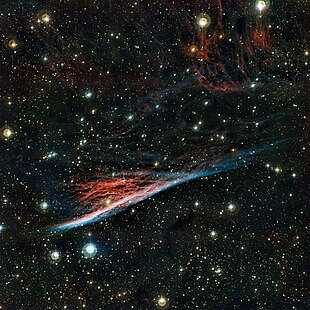Bleistiftnebel
| Emissionsnebel | |
|---|---|
| NGC 2736 | |
 | |
| Aufnahme des MPG/ESO-2,2-m-Teleskops | |
| AladinLite | |
| Sternbild | Segel des Schiffs |
| Position Äquinoktium: J2000.0, Epoche: J2000.0 | |
| Rektaszension | 09h 00m 16,9s[1] |
| Deklination | -45° 56′ 53″[1] |
| Erscheinungsbild | |
| Winkelausdehnung | 20' × 2'[2] |
| Ionisierende Quelle | |
| Physikalische Daten | |
| Entfernung | 815 Lj |
| Durchmesser | 5 Lj |
| Geschichte | |
| Entdeckung | John Herschel |
| Datum der Entdeckung | 1. März 1835 |
| Katalogbezeichnungen | |
| NGC 2736 • ESO 260-N14, h 3145, GC 1745 | |
NGC 2736, manchmal auch Bleistiftnebel genannt, ist ein Emissionsnebel im Sternbild Vela, welcher 815 Lichtjahre von der Erde entfernt ist. NGC 2736 ist der Überrest einer gewaltigen Explosion einer Supernova vor etwa 11.000 Jahren. Diese Supernova wird die Vela-Supernova genannt. Zu Beginn der Explosion soll sie 250 mal heller geleuchtet haben als die Venus und sich mit einer Geschwindigkeit von 40 Millionen Kilometern pro Stunde ausgedehnt haben. Die Geschwindigkeit hat sich bis heute auf 640.000 Kilometern pro Stunde verlangsamt.
Diese Sternenexplosion hinterließ einen Pulsar, der im Jahr 1968 entdeckt und später auch optisch identifiziert wurde, seine Rotationsperiode beträgt 89 Millisekunden.[3]
Das Objekt wurde am 1. März 1835 vom britischen Astronomen John Herschel entdeckt.[4]

Literatur
- König, Michael & Binnewies, Stefan (2023): Bildatlas der Sternhaufen & Nebel, Stuttgart: Kosmos, S. 266
Einzelnachweise
Weblinks
- SIMBAD Astronomical Database
- Capella Observatory
- Antilhue - Chile
- astronews.com: Bild des Tages 7. Juni 2013
- astronews.com: Überbleibsel einer kosmischen Katastrophe 10. Juni 2003
- Gum Nebula (NGC 2736)
- GoBlack
Auf dieser Seite verwendete Medien
From the NASA press release:
- Remnants from a star that exploded thousands of years ago created a celestial abstract portrait, as captured in this NASA Hubble Space Telescope image of the Pencil Nebula.
- Officially known as NGC 2736, the Pencil Nebula is part of the huge Vela supernova remnant, located in the southern constellation Vela. Discovered by Sir John Herschel in the 1840s, the nebula's linear appearance triggered its popular name. The nebula's shape suggests that it is part of the supernova shock wave that recently encountered a region of dense gas. It is this interaction that causes the nebula to glow, appearing like a rippled sheet.
- In this snapshot, astronomers are looking along the edge of the undulating sheet of gas. This view shows large, wispy filamentary structures, smaller bright knots of gas, and patches of diffuse gas. The Hubble Heritage Team used the Advanced Camera for Surveys in October 2002 to observe the nebula. The region of the Pencil Nebula captured in this image is about three fourths of a light-year across. The Vela supernova remnant is 114 light-years (35 parsecs) across. The remnant is about 815 light-years (250 parsecs) away from our solar system.
- The nebula's luminous appearance comes from dense gas regions that have been struck by the supernova shock wave. As the shock wave travels through space [from right to left in the image], it rams into interstellar material. Initially the gas is heated to millions of degrees, but then subsequently cools down, emitting the optical light visible in the image.
- The colors of the various regions in the nebula yield clues about this cooling process. Some regions are still so hot that the emission is dominated by ionized oxygen atoms, which glow blue in the picture. Other regions have cooled more and are seen emitting red in the image (cooler hydrogen atoms). In this situation, color shows the temperature of the gas. The nebula is visible in this image because it is glowing.
- The supernova explosion left a spinning pulsar at the core of the Vela region. Based on the rate at which the pulsar is slowing down, astronomers estimate that the explosion may have occurred about 11,000 years ago. Although no historical records of the blast exist, the Vela supernova would have been 250 times brighter than Venus and would have been easily visible to southern observers in broad daylight. The age of the blast, if correct, would imply that the initial explosion pushed material from the star at nearly 22 million miles per hour. As the Vela supernova remnant expands, the speed of its moving filaments, such as the Pencil Nebula, decreases. The Pencil Nebula, for example, is moving at roughly 400,000 miles per hour.
Autor/Urheber: Credit: ESO, Lizenz: CC BY 3.0
The Pencil Nebula, a strangely shaped leftover from a vast explosion
The oddly shaped Pencil Nebula (NGC 2736) is pictured in this image from ESO’s La Silla Observatory in Chile. This nebula is a small part of a huge remnant left over after a supernova explosion that took place about 11 000 years ago. The image was produced by the Wide Field Imager on the MPG/ESO 2.2-metre telescope at ESO’s La Silla Observatory in Chile.
Credit: ESO
About the Image Id: eso1236a Type: Observation Release date: 12 September 2012, 12:00 Related releases: eso1236 Size: 8357 x 8357 px About the Object Name: NGC 2736 Type: • Milky Way : Nebula : Type : Supernova Remnant Distance: 800 light years Coordinates Position (RA): 9h 0m 12.02s Position (Dec): -45° 57' 0.24" Field of view: 33.16 x 33.16 arcminutesOrientation: North is 90.1° left of vertical

